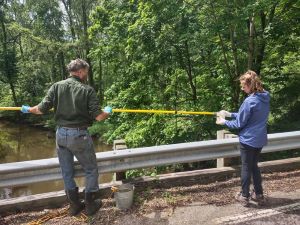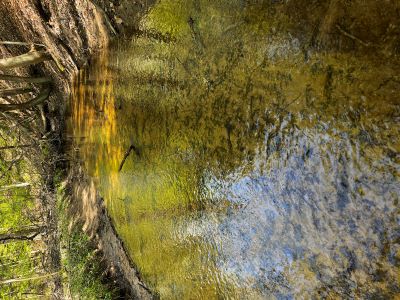Home>Our Work>E.coli Monitoring
E.Coli Monitoring - Part 2
INTRODUCTION
 Two Rivers Coalition conducted its most recent E. coli testing in the Black River watershed in 2022 and in the Paw Paw River watershed in 2021. That testing establishes unequivocally that there is a serious problem with E. coli contamination in both watersheds. In addition, DNA testing of water samples from the Black River watershed in 2022 showed the presence of human fecal matter at every site tested.
Two Rivers Coalition conducted its most recent E. coli testing in the Black River watershed in 2022 and in the Paw Paw River watershed in 2021. That testing establishes unequivocally that there is a serious problem with E. coli contamination in both watersheds. In addition, DNA testing of water samples from the Black River watershed in 2022 showed the presence of human fecal matter at every site tested.
The conclusion is inescapable that at least one source of E. coli in our waterways is human waste from leaking/failing/illicit private septic systems. TRC believes the most obvious solution is enactment of a statewide septic code regulating the design and construction of private septic systems and mandating periodic inspection of existing systems.
Explore the data using the map below. Click the arrow/window symbol on top left to see the map key and layers available. Click the broken square on top right to expand to full view which will also show the key and available layers.
HISTORY OF TRC TESTING PROGRAM AND RESULTS
Two Rivers Coalition has been conducting testing in the Black River and Paw Paw River watersheds since 2017 to determine E. coli levels and sources (See Part 1 for more details). According to the U.S. Environmental Protection Agency, E. coli is a type of bacteria that lives in the intestines of people and animals and is considered an indicator organism, used to identify fecal contamination in freshwater and indicate the possible presence of disease-causing bacteria and viruses (pathogens). The threshold for E. coli set by the E.P.A. for total body contact (such as swimming) is 300 colony forming units (cfu) per 100 milliliters. The threshold for partial body contact (such as wading or paddling) is 1,000 cfu/100 ml.
From 2017 thru 2020, TRC tested multiple sites in both watersheds twice during the year. One set of water samples were taken during base flow when there had been no rain for at least three days. In theory, there should be no agricultural field run-off contamination during base flow testing. Therefore, if there were high E. coli levels found during base flow conditions, the suggestion would be the source was from leaking private septic systems. The other set of water samples was taken within 24 hours of a rain event of at least .5 inches. In theory again, this testing should catch contaminants carried into the stream from run-off. High E. coli levels after rain events would suggest cow manure run-off as the source. The results from our testing in 2017-2020 were alarming and perplexing.
Results for the Black River showed all ten testing sites exceeded the 300 cfu standard for total body contact during both base flow and rain event testing. In addition, all ten sites exceeded the 1000 cfu threshold for partial body contact during rain events. Results from the Paw Paw River showed 16 out of 19 sites exceeded the 300 cfu standard and 4 sites exceeded the 1000 cfu threshold during base flow testing. Eighteen out of 19 sites exceeded 300 cfu and 4 out of 19 sites exceeded 1000 cfu during rain event testing. These results from both watersheds show very serious levels of E. coli contamination during both rain events and at base flow during dry intervals.
Realizing that it was important to try to determine the source of the E. coli contamination but having serious budget constraints, TRC implemented a less costly alternative to expensive DNA testing in 2020. Duplicate water samples were sent to a company which used highly trained dogs that would signal in the presence of human sewage. Those canine results showed a majority of the testing sites in both watersheds had detectable levels of human sewage. Although not as conclusive as DNA testing, the canine results strongly suggested that there was a human source as at least part of the E. coli contamination.
IMPROVED TESTING PROTOCOL AND 2021 RESULTS FROM PPR
TRC presented its 4 years of data from 2017-2020 to the Michigan Department of Energy, Great Lakes, and Environment (EGLE) and applied for a grant in 2021 to do more in depth testing, including DNA source tracking. Eventually TRC was awarded a grant that funded E. coli testing and DNA source tracking on the Black River watershed which took place in 2022. Importantly, TRC worked closely with EGLE to upgrade our testing methodology to bring it in line with more rigorous EGLE requirements. This allowed our new data to be relied upon by EGLE and to be compared to findings from other watersheds throughout the state.
While waiting for final approval of the EGLE grant, TRC implemented the improved E. coli testing protocol in its testing on the Paw Paw River in 2021. Similar to the 2017-2020 data, high E. coli levels were again found. During base flow testing, 11 out of 19 sites exceeded the total body contact threshold. One out of 19 sites exceeded the partial body contact threshold. Again, the E. coli levels were much higher after a rain event. Eighteen out of 19 sites exceeded the total body contact threshold after a rain event. Fourteen out of 19 sites exceeded the partial body contact threshold. In other words, it would not be safe to wade after a rain event in the vast majority of the sites tested in the Paw Paw River watershed in 2021.
RESULTS FROM 2022 TESTING IN THE BLACK RIVER WATERSHED
Thanks to the grant funding from EGLE, the testing in the Black River watershed performed in 2022 was more robust than done in the past. One aspect of the testing was to test six sites (2 each on the North, Middle, and South Branches) weekly over a 30 day period in order to calculate a type of average known as a 30 day geometric mean (GM). Four out of six sites had a 30 day GM over 300 cfu. Only the two Middle Branch sites were under 300, but just barely (285 and 293).
Another aspect of the testing involved base flow and rain event testing at the six primary sites, as well as two smaller creek sites. Testing during base flow conditions showed four out of eight sites had a daily GM in excess of 300 cfu. Testing of the eight sites after a rain event showed every single site had a daily GM in excess of 300 cfu. And five out of eight sites had a daily GM in excess of 1000 cfu. This means it would be unsafe to have any contact whatsoever with stream water at those locations after a rain event.
An important aspect of the testing in 2022 involved microbial source tracking (MST). During the base flow and rain event testing, duplicate water samples were taken for testing at the Annis Water Resources Institute at the GVSU campus in Muskegon. Those samples underwent a type of DNA testing known as ddPCR analysis.
During the base flow testing, five out of five sites with high E. coli levels also showed the presence of human fecal marker (HF 183). Zero sites showed the presence of the specific cow fecal marker (CowM2). Four out of five sites showed the presence of the general ruminant fecal marker (Rum2Bac) which can include cows, deer, sheep, goats, etc.
MST testing after a rain event revealed that eight out of eight sites showed the presence of human fecal marker. Zero sites showed the specific cow fecal marker. Eight out of eight sites showed the general ruminant marker.
SMALL CREEK TESTING RESULTS IN BLACK RIVER WATERSHED
 The final aspect of the 2022 testing involved testing of multiple sites in two small creek sub-watersheds of the Black River, those being Cedar Creek and Eastman Creek. The E. coli results from base flow testing on Cedar Creek showed five out of seven sites exceeded 300 cfu. MST results showed five out of seven sites had detectable levels of human fecal marker. Four out of seven sites had detectable levels of general ruminant fecal marker and two out of seven sites had detectable levels of cow specific fecal marker.
The final aspect of the 2022 testing involved testing of multiple sites in two small creek sub-watersheds of the Black River, those being Cedar Creek and Eastman Creek. The E. coli results from base flow testing on Cedar Creek showed five out of seven sites exceeded 300 cfu. MST results showed five out of seven sites had detectable levels of human fecal marker. Four out of seven sites had detectable levels of general ruminant fecal marker and two out of seven sites had detectable levels of cow specific fecal marker.
After a rain event, the E. coli results showed seven out of seven sites exceeded 1000 cfu. MST results showed seven out of seven sites had detectable levels of human fecal marker. In addition, seven out of seven sites had detectable levels of general ruminant and one site had a detectable level of cow specific fecal marker.
Similar results were found in Eastman Creek. During base flow, E. coli levels at three out of six sites exceeded 300 cfu and another site was at 297. MST results during base flow conditions showed three out of four sites had detectable levels of human fecal marker. Also, two out of four sites had detectable levels of general ruminant fecal marker, while no sites had detectable levels of cow specific fecal marker.
After a rain event, E. coli levels at five out of six sites on Eastman Creek exceeded 1000 cfu. MST results showed five out of five sites had detectable levels of human fecal marker. Five out of five sites had detectable levels of general ruminant fecal marker and again, no sites had detectable levels of cow specific fecal marker.
In general, the E. coli and MST results from the small stream testing were similar to the findings in the Black River watershed at large. There are unacceptably high E. coli levels during base flow conditions. There are even higher levels after a rain event. Human fecal markers were detected at almost all sites with high E. coli levels.
CONCLUSION
The inescapable conclusion from the 2022 testing of the Black River watershed is that there is a widespread problem with E. coli contamination. E. coli levels are unacceptably high during base flow conditions and are even worse after a significant rain event making many areas unsafe for partial body contact. These results mirror what was found during the testing in the Paw Paw River watershed in 2021 using the improved testing protocol. The fact that similar results were found in two separate watersheds suggests that the contamination problem is at least regional in nature and likely not specific to these two river systems.
Can we say with certainty what the cause of the E. coli contamination is? There is no doubt that one cause is private septic systems given the presence of human fecal material at every site that had high E. coli levels. The most plausible explanation is that there are a significant number of private septic systems that are failing and leaking human waste. According to EGLE, there are over one million homes and businesses in the state that rely on private septic systems, and it is estimated that 330,000 of them are failing. It is also possible that there are illicit septic tanks that do not connect to a drain field but, instead, simply have a pipe running out to a ditch. This would help explain why there were higher E. coli levels after a rain event because rainwater was flushing human waste residue from ditches.
Can we rule out other contributing sources for the E. coli contamination? Not completely. Our original hypothesis had been that high E. coli levels during base flow conditions would suggest leaking septic tanks while high levels after a rain event would suggest manure run-off from agricultural fields. Somewhat surprisingly, our testing has consistently shown high levels at base flow, but even higher levels after rain events. There was very little evidence of the cow specific fecal marker in the results of the DNA testing. This does not mean that we can absolutely rule out manure run-off. To be sure, we would have to know the exact schedule of when manure was being applied to fields and then have a significant rain event that coincided with our testing.
Our DNA testing did show widespread presence of another fecal marker, a broad category called general ruminant. Included in the general ruminant group are cows, sheep, goats, and deer. Because we found very little evidence of the cow specific fecal marker, it seems unlikely that cattle are causing the high levels of general ruminant fecal marker. But in the small sub-watersheds, we did not see evidence for large scale sheep, or goat agricultural operations. So, could the culprit driving the general ruminant fecal marker levels be deer? Certainly, it is possible, given the historically large deer population. But the bottom line is that there would not be a lot anyone could do about deer as the source of E. coli contamination in our waterways. On the other hand, there is a clear path forward with regard to the incontrovertible evidence that human fecal material is contributing to the high E. coli levels and that is enactment of a statewide septic code.
It is almost beyond belief that Michigan is the only state in the nation that does not have a statewide law regulating private septic systems. As mentioned earlier, EGLE calculates there are over one million homes and businesses in the state that rely on private septic systems and estimates that 330,000 of them are failing.
TRC has submitted its data from the Black River and Paw Paw River testing to EGLE and is hopeful that it may be useful as legislators in Lansing once again debate enacting a statewide septic code. Currently, proposed legislation has been introduced in the state legislature (Senate Bills 299 and 300 and House Bills 4479 and 4480). These proposed laws would set forth minimum design and construction standards for private septic systems and require periodic inspection of existing systems. TRC firmly supports enactment of a statewide septic code and believes it will help address the widespread E. coli contamination in Michigan’s lakes, streams, and rivers. Michigan has the most fresh water of any state in the lower forty-eight states and it is time that we finally catch up to the rest of the nation in protecting that precious resource.

![Crabapple Pond [Click here to view full size picture] Crabapple Pond [Click here to view full size picture]](media/pages/tn_crabapple_pond_740x192.jpg)